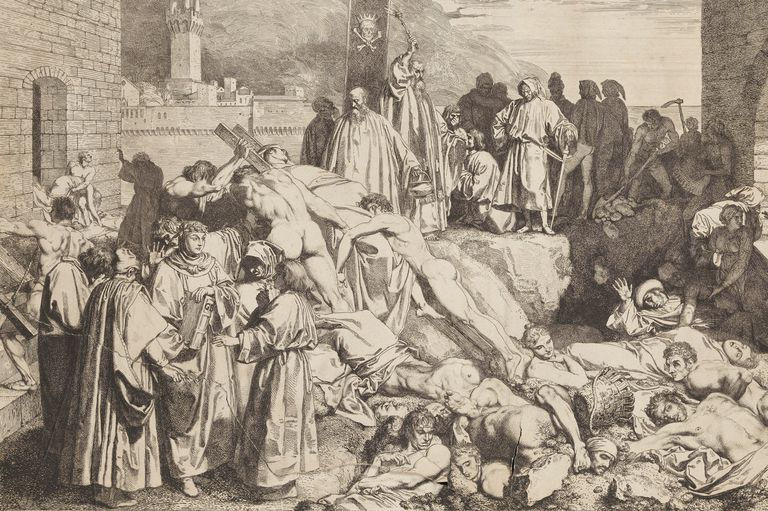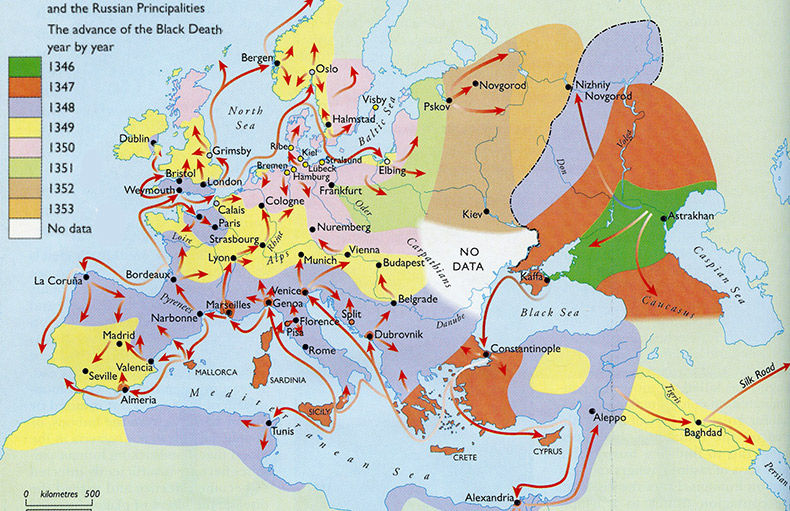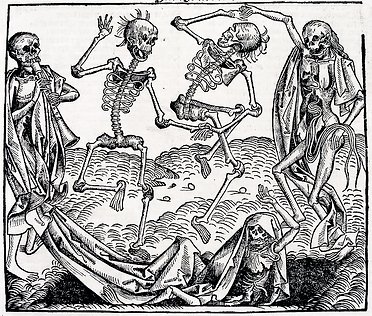
The Black Plague
During the 13th and 14th century, Europe experienced a huge population growth, and there was a great increase in epidemic diseases caused by increases in population density and in trade and transport. While the culture and populations changed, knowledge of the nature of disease, was still minimal. Most people still believed plague and mass illness to be a punishment from God for their sins, and believed disease to be able to be prayed away. Under such beliefs, practices like bloodletting were common, and disease mortality was high since no one was actually being treated.
Starting from the later half of the 14th century, a plague known as the Black Death swept over Europe for only 4 years, and claimed the lives of more than sixty percent of the Europe’s population. The disease, yersinia pestis emerged from the deserts of Mongolia, traveled from East Asian countries such as China, and then to Europe, using the silk road for transmission. Yersinia pestis infected rats and fleas stowed away on trade ships that crossed from East Asia to Europe, which then bit human sailors. When they landed in the ports of Sicily in 1347, it started to spread rapidly, taking advantage of the crowded urban planning.
At the time, the common folk and the monarchs had a huge income gap, and most of the population was living in terrible conditions. The streets were unplanned, poorly developed and unsanitary, as the main sources of water was used for both sewage and drinking, houses were crowded and the majority of villagers were illiterate, making the spread of news about the disease slower, so the disease spread faster than the subcontinent could respond. Because even the villages of the 14th century were tightly knit through trade routes with big cities, the plague reached even the most remote villages. It’s worth mentioning here that to this day, Yersinia Pestis can only be treated, not cured. Countries neighboring Italy shut their borders, villages quarantined their sick, and citizens fleeing the plague were killed where they went, out of fears that they carried the disease with them. Their efforts proved futile. The Black death kept following major trade routes north, and by 1351, Germany, France, England, Italy, Russia, Norway, Sweden, and Russia had been hit by the Black Plague.
Eventually the plague died out mid way through the fifteenth century after the death toll reached high enough that the population could not infect each other, but by then, the plague had reduced the population in Europe to about a three quarters of it’s original population. Because the plague had affected the working class, peasants, artisans, and merchants the hardest because of their poor living conditions, their population drop resulted in a higher value being placed on labour. In the next thirty years, they would revolt, and topple the old societal structures that shaped the Middle Ages. Kings and churches lost their importance, as they were proven powerless in the time of the plague, and workers and artisans built their way out of poverty. This started the age of the renaissance, and became the basis of Modern Europe.
1342
1347
1348/4
1348/6
1348/9
1352
1354
October Revolution
Plague reaches Genoa, Italy
Plague reaches Normandy, Italy
Plague reaches London
Princess of England dies from Plague
Plague reaches Moscow, Russia
The height of the plague ends, but comes back multiple times over 40 years.

Time map of the spread of the plague

Symptoms of the Bubonic Plague, and an illustrations of a plague doctor's garb. Many Halloween costumes are inspired by the plague doctor suit. The immense amount of death inspired many artistic pieces such as the Danse Macabre and the painting Triumph of Death.




Pretty horrifying, but a lot came out of the rubble, including modern Europe and the Renaissance. Though it was a terrible tragedy, it's certainly a great section of history that we can examine, and see the direct causalities and end results, especially since life was so simply in the Middle Ages.
The quiz
1. Where did the Bubonic Plague take place? (Roughly)
2. What is the broad estimate of deaths caused by the Bubonic Plague?
3. What was the system of government that the plague happen under?
4. What happened to society after so many people died?
5. What years did the plague peak in it's death toll?